Random-Orbit Sander: What Does It Do? Should You Buy One?
Random-orbit sanders combine the aggressiveness of belt sanders with the accuracy of hand sanding.
Belt sanders may work the fastest, finishing sanders may work the smoothest, and hand sanding may be the most accurate — but random-orbit sanders do a darn good job on all three fronts.
How To Choose A Random-Orbit Sander
If you are planning on buying a small sander, you might be interested in knowing the difference between orbital sanders and random-orbit sanders. Are they any good?
Compared to traditional orbital sanders, random-orbit sanders sand quicker, leave fewer swirl marks (those ugly pigtail-shaped scratches), can use coarser grits for rapid stock removal, and offer optional dust control devices. They also offer the convenience of self-stick sandpaper.
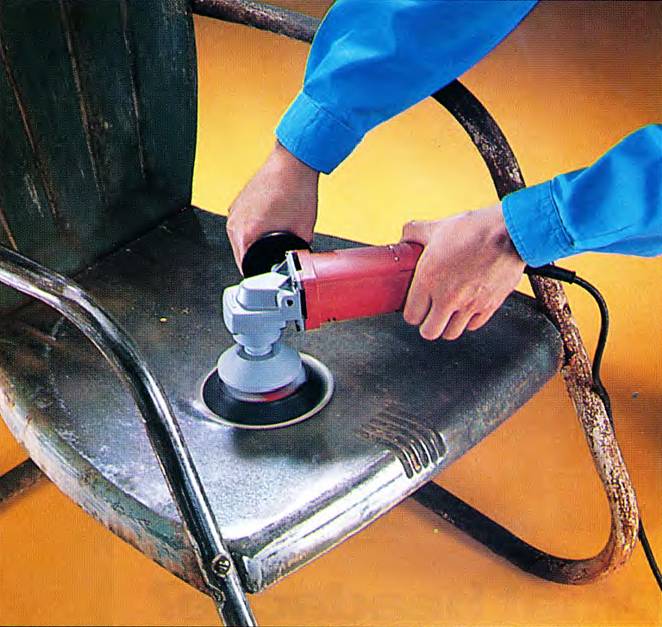
Most major tool manufacturers make random-orbit sanders. Some are powerful, two-handed tools that resemble a body grinder; others are lighter weight and better for close quarters and finish work. Take your pick. I strongly recommend, however, that you choose a sander with some form of a dust collector.
The sandpaper discs can be adhesive-backed or attached with a Velcro hook-and-loop system. Adhesive-backed paper is less expensive and more readily available. while the hook-and-loop is more convenient and much longer-lasting.
Hook-and-loop is the best choice for users who switch grits a lot on small projects because the pads can be removed and reused repeatedly.
Woodworkers, carpenters, and do-it-yourselfers who’ve tried them would sooner give up their work boots than part with their random-orbit sander.
These sanders, in pneumatic (air powered) form, have actually been around a long time in the automotive industry. Known as “dual action” sanders, they’re used by body shops for paint preparation and finish-sanding.
The electric models, designed for portability with the woodworker and DIYer in mind, have taken the tool market by storm. Here’s why.
Why Should I Buy A Random-Orbit Sander?
At first glance, these tools may remind you of an ordinary disc sander — but that’s where the similarity ends.
Random-orbit sanders combine a spinning motion with a secondary orbital motion (Photo 1) made possible by an offset counterbalance. When you apply pressure, the sanding pad moves around the work area much the same as a random circular hand movement, only much faster.
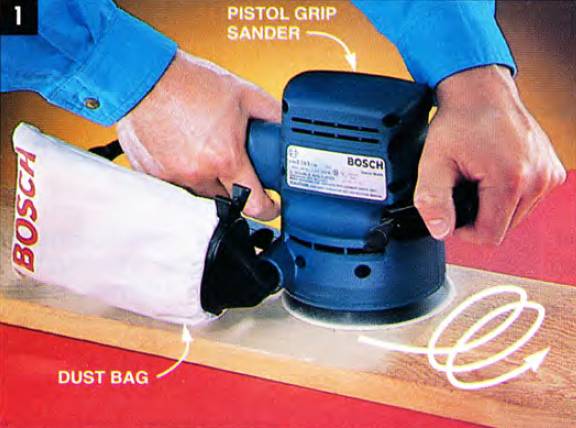
Grip the sander firmly (or the random motion will decide your path for you). This pistol-grip model has enough power to smooth a rough-sewn cedar board.
You can sand many times faster with the random-orbit sander than with conventional vibrating or orbital finish sanders. The random “jitterbug” movement of the pad and disc ensures an unrepeated path for the sandpaper.
The end result is a swirl-free finish — even on joints where wood grain meets perpendicularly (Photo 2).
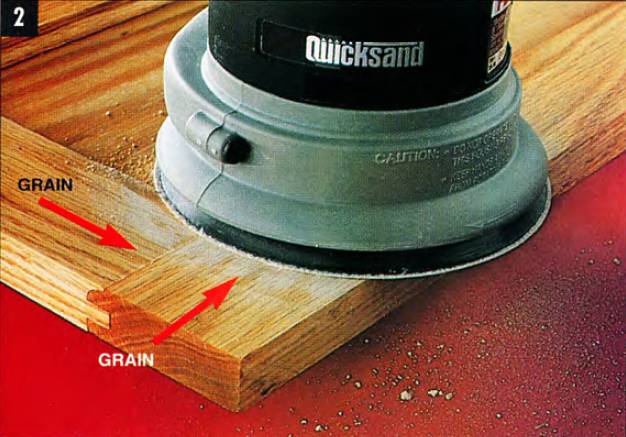
Sanding opposing grain without leaving swirl marks is this sender’s real forte. You can even use coarser grits without leaving deep scratch marks.
How Do I Use A Random-Orbit Sander?
Using these tools for the first time is like dancing with a new partner.
The random motion has a tendency to lead, so take control and you’ll get along just fine.
- Before tackling a real project, practice on some scrap material.
- Place the sander flat on your workpiece before you turn on the switch. Otherwise, you may catch the sanding disc on the edge of your work and tear it — or worse yet, gouge the work surface of a veneer or softwood such as pine.
- To keep small workpieces from sliding while sanding, place foam carpet pad or a router pad under them, or use a clamp.
- Wear safety glasses, hearing protection, and a respirator or dust mask whenever you use your sander.
- Keep the cord away from the action or you could end up nipping or breaking it.
- If the pad that holds the sandpaper becomes damaged, replace it or the finely tuned balance of the counterweight will be disturbed.
Tips For Sanding With A Random-Orbit Sander
The list of uses is nearly endless, but here are some areas where random-orbit sanders really stand out:
- On cabinet doors and face frames (Photo 2) where boards meet at right angles to one another. Random-orbit sanders smooth the joint without leaving swirl marks across the grains of the wood.
- On tabletops, cutting boards, and other flat surfaces. Worked in an arcing motion, they sand quickly and smoothly. Be careful on plywood and veneer tops; you can sand right through the thin wood skin.
- For refinishing and painting preparation. The sander cuts quickly through old paint or the residue left by chemical strippers. Before repainting, improve the bond of your new paint by sanding and lightly roughening the surface (use a fine, 220-grit sandpaper for this task). Random-orbit sanders will also remove paint quickly from metal surfaces that need preparation for priming and repainting. Latex paints can gum up the sanding discs; oil paints are much easier to remove. Remember, sanding lead-based paint can be hazardous to your health; use one of the test kits on the market to see if the paint contains lead.
- For buffing a faded paint job or unpainted brass and copper (Photo 3). Use a buffing attachment and special polishing compounds as needed.

Buff your car’s finish after waxing. Use at low RPM only, and be careful around style lines and dyes. Too much heat could wear away the paint.
What Is The Best Random-Orbit Sander?
Random-orbit sanders fall into three broad categories:
Right Angle Sanders
Right angle sanders (opening photo) are the most aggressive. Their powerful motors make them ideal for heavy-duty uses like sanding large surfaces, tabletops, wood and fiberglass boats. and auto body panels.
Their resemblance to angle grinders is not just coincidental. In fact, if you have a 4-1/2 in. or 5-in. angle grinder, an accessory attachment is available to turn your grinder into a random-orbit sander.
The right angle sander is available in 5- or 6-in. diameter pad styles, as well as in single or variable speeds.
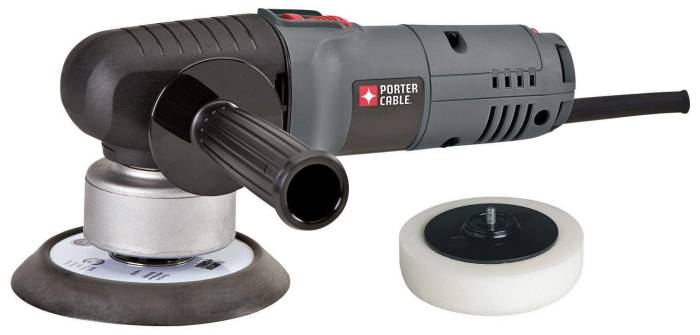
The Porter-Cable 7346SP has a 6-inch pad and can be adjusted between electronically with a speed dial between 2,500 and 6,800 OPM. You can buy it with an optional lamb wool polishing pad, so you can use it when woodworking and taking care of your car, too. Click here to read Amazon customer reviews and buy it now.
Pistol Grip Sanders
Pistol grip sanders (Photo 1) are often equipped with a “D”-shaped handle that helps you control the tool.
These tools are less powerful and aggressive than their right angle cousins but are much easier to control. They’re the most versatile of all the orbitals. I use mine for everything from smoothing rough-sawn boards to fine sanding furniture
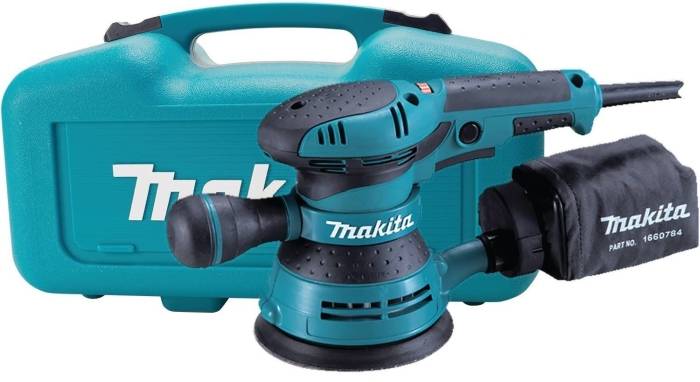
The pistol grip with trigger switch in the Makita BO5041K, plus the second hand grip, both allow for more comfort when sanding. It’s also lightweight, meaning less stress on shoulders and arms. This is a great choice and it’ll last you very, very long. Click here to buy it from Amazon.
(Battery-Powered) Palm Grip Sanders
Palm grip sanders (Photo 6) are best suited for light-duty sanding such as finish-sanding furniture and cabinetry. Don’t expect to sand a stack of rough-sawn beams with this type.
But they have excellent control and can be used with one hand for hard-to-reach spots.
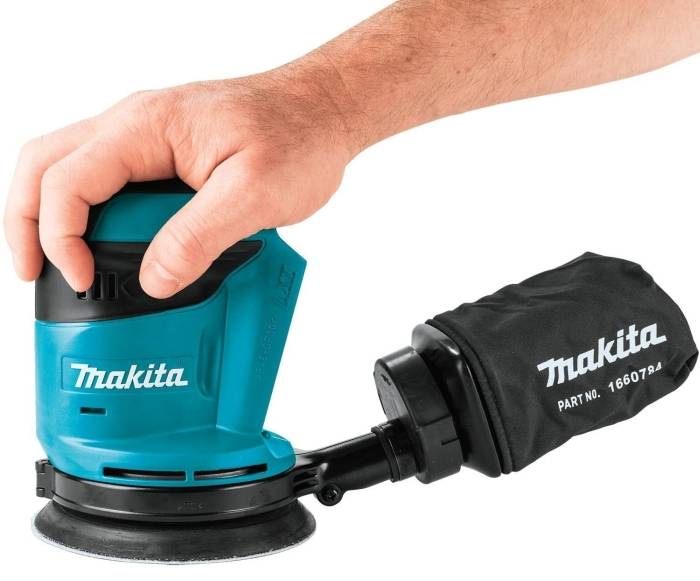
Many tool manufacturers are releasing cordless versions of palm grip random-orbit sanders, meaning you can choose between the Makita XOB01Z (pictured above), the Ryobi P411, the Black & Decker BDCRO20C, or the Ridgid R8606B based on which battery system you already use. Super convenient! All links point to the respective Amazon product pages.
Sandpaper Types And Dust Collection
Sanding discs are secured to the sander by either a hook-and-loop system (Photo 4), or with a pressure sensitive adhesive (Photo 5). These special papers are expensive but they’re the key to the success of these tools. Quick paper changes are a real advantage with those sanders.
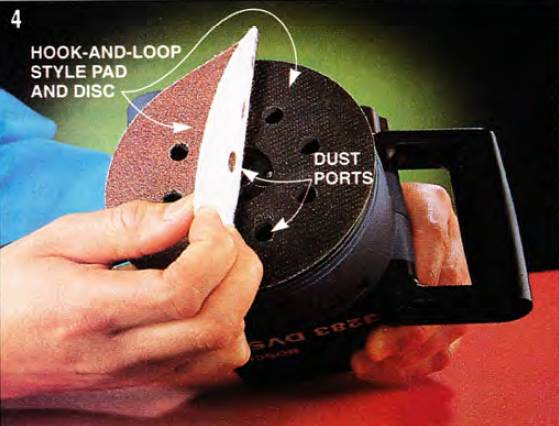
Apply and remove pressure sensitive adhesive (PSA) discs, working from one edge of the pad. Remove PSA discs right after use or they become bears to get off.
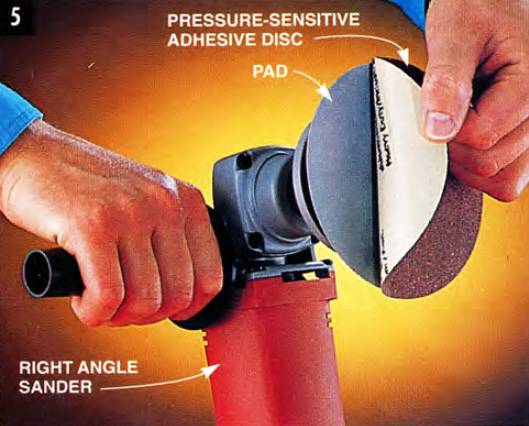
Hook-and-loop pads and discs allow you to change and reuse paper more easily. The pad has tiny hooks that grab onto fuzzy-backed discs.
Random-orbit sanders really kick up the dust, so do yourself a favor and get one with some type of dust collection system (Photo 6).
These have built-in exhaust fans that stick dust through holes in the disc and pad and then deposit it in a bag canister or a shop vacuum.
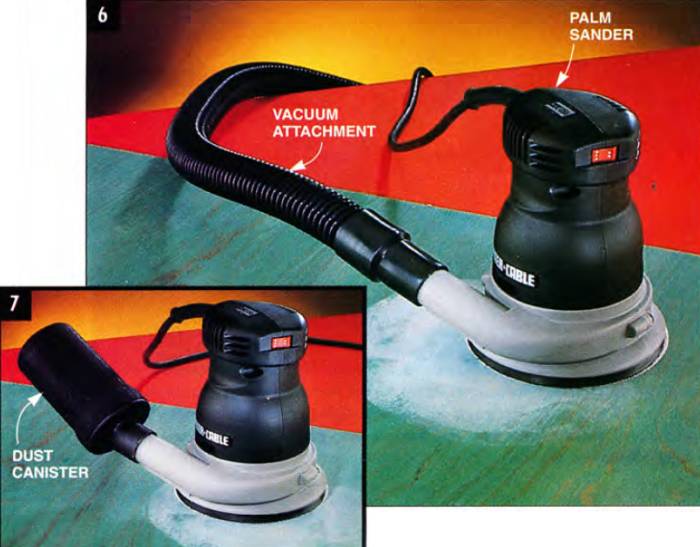
Keep the dust to a minimum with dust collection accessories. The small diameter vacuum hose connects to your shop vacuum for greater dust control. The canister stays out of the way and is easily removed and emptied. Bags are available on other models.
Random-orbit sanders combine the aggressiveness of belt sanders with the accuracy of hand sanding.
Belt sanders may work the fastest, finishing sanders may work the smoothest, and hand sanding may be the most accurate — but random-orbit sanders do a darn good job on all three fronts.
How To Choose A Random-Orbit Sander
If you are planning on buying a small sander, you might be interested in knowing the difference between orbital sanders and random-orbit sanders. Are they any good?
Compared to traditional orbital sanders, random-orbit sanders sand quicker, leave fewer swirl marks (those ugly pigtail-shaped scratches), can use coarser grits for rapid stock removal, and offer optional dust control devices. They also offer the convenience of self-stick sandpaper.

Most major tool manufacturers make random-orbit sanders. Some are powerful, two-handed tools that resemble a body grinder; others are lighter weight and better for close quarters and finish work. Take your pick. I strongly recommend, however, that you choose a sander with some form of a dust collector.
The sandpaper discs can be adhesive-backed or attached with a Velcro hook-and-loop system. Adhesive-backed paper is less expensive and more readily available. while the hook-and-loop is more convenient and much longer-lasting.
Hook-and-loop is the best choice for users who switch grits a lot on small projects because the pads can be removed and reused repeatedly.
Woodworkers, carpenters, and do-it-yourselfers who’ve tried them would sooner give up their work boots than part with their random-orbit sander.
These sanders, in pneumatic (air powered) form, have actually been around a long time in the automotive industry. Known as “dual action” sanders, they’re used by body shops for paint preparation and finish-sanding.
The electric models, designed for portability with the woodworker and DIYer in mind, have taken the tool market by storm. Here’s why.
Why Should I Buy A Random-Orbit Sander?
At first glance, these tools may remind you of an ordinary disc sander — but that’s where the similarity ends.
Random-orbit sanders combine a spinning motion with a secondary orbital motion (Photo 1) made possible by an offset counterbalance. When you apply pressure, the sanding pad moves around the work area much the same as a random circular hand movement, only much faster.

Grip the sander firmly (or the random motion will decide your path for you). This pistol-grip model has enough power to smooth a rough-sewn cedar board.
You can sand many times faster with the random-orbit sander than with conventional vibrating or orbital finish sanders. The random “jitterbug” movement of the pad and disc ensures an unrepeated path for the sandpaper.
The end result is a swirl-free finish — even on joints where wood grain meets perpendicularly (Photo 2).

Sanding opposing grain without leaving swirl marks is this sender’s real forte. You can even use coarser grits without leaving deep scratch marks.
How Do I Use A Random-Orbit Sander?
Using these tools for the first time is like dancing with a new partner.
The random motion has a tendency to lead, so take control and you’ll get along just fine.
- Before tackling a real project, practice on some scrap material.
- Place the sander flat on your workpiece before you turn on the switch. Otherwise, you may catch the sanding disc on the edge of your work and tear it — or worse yet, gouge the work surface of a veneer or softwood such as pine.
- To keep small workpieces from sliding while sanding, place foam carpet pad or a router pad under them, or use a clamp.
- Wear safety glasses, hearing protection, and a respirator or dust mask whenever you use your sander.
- Keep the cord away from the action or you could end up nipping or breaking it.
- If the pad that holds the sandpaper becomes damaged, replace it or the finely tuned balance of the counterweight will be disturbed.
Tips For Sanding With A Random-Orbit Sander
The list of uses is nearly endless, but here are some areas where random-orbit sanders really stand out:
- On cabinet doors and face frames (Photo 2) where boards meet at right angles to one another. Random-orbit sanders smooth the joint without leaving swirl marks across the grains of the wood.
- On tabletops, cutting boards, and other flat surfaces. Worked in an arcing motion, they sand quickly and smoothly. Be careful on plywood and veneer tops; you can sand right through the thin wood skin.
- For refinishing and painting preparation. The sander cuts quickly through old paint or the residue left by chemical strippers. Before repainting, improve the bond of your new paint by sanding and lightly roughening the surface (use a fine, 220-grit sandpaper for this task). Random-orbit sanders will also remove paint quickly from metal surfaces that need preparation for priming and repainting. Latex paints can gum up the sanding discs; oil paints are much easier to remove. Remember, sanding lead-based paint can be hazardous to your health; use one of the test kits on the market to see if the paint contains lead.
- For buffing a faded paint job or unpainted brass and copper (Photo 3). Use a buffing attachment and special polishing compounds as needed.

Buff your car’s finish after waxing. Use at low RPM only, and be careful around style lines and dyes. Too much heat could wear away the paint.
What Is The Best Random-Orbit Sander?
Random-orbit sanders fall into three broad categories:
Right Angle Sanders
Right angle sanders (opening photo) are the most aggressive. Their powerful motors make them ideal for heavy-duty uses like sanding large surfaces, tabletops, wood and fiberglass boats. and auto body panels.
Their resemblance to angle grinders is not just coincidental. In fact, if you have a 4-1/2 in. or 5-in. angle grinder, an accessory attachment is available to turn your grinder into a random-orbit sander.
The right angle sander is available in 5- or 6-in. diameter pad styles, as well as in single or variable speeds.

The Porter-Cable 7346SP has a 6-inch pad and can be adjusted between electronically with a speed dial between 2,500 and 6,800 OPM. You can buy it with an optional lamb wool polishing pad, so you can use it when woodworking and taking care of your car, too. Click here to read Amazon customer reviews and buy it now.
Pistol Grip Sanders
Pistol grip sanders (Photo 1) are often equipped with a “D”-shaped handle that helps you control the tool.
These tools are less powerful and aggressive than their right angle cousins but are much easier to control. They’re the most versatile of all the orbitals. I use mine for everything from smoothing rough-sawn boards to fine sanding furniture

The pistol grip with trigger switch in the Makita BO5041K, plus the second hand grip, both allow for more comfort when sanding. It’s also lightweight, meaning less stress on shoulders and arms. This is a great choice and it’ll last you very, very long. Click here to buy it from Amazon.
(Battery-Powered) Palm Grip Sanders
Palm grip sanders (Photo 6) are best suited for light-duty sanding such as finish-sanding furniture and cabinetry. Don’t expect to sand a stack of rough-sawn beams with this type.
But they have excellent control and can be used with one hand for hard-to-reach spots.

Many tool manufacturers are releasing cordless versions of palm grip random-orbit sanders, meaning you can choose between the Makita XOB01Z (pictured above), the Ryobi P411, the Black & Decker BDCRO20C, or the Ridgid R8606B based on which battery system you already use. Super convenient! All links point to the respective Amazon product pages.
Sandpaper Types And Dust Collection
Sanding discs are secured to the sander by either a hook-and-loop system (Photo 4), or with a pressure sensitive adhesive (Photo 5). These special papers are expensive but they’re the key to the success of these tools. Quick paper changes are a real advantage with those sanders.

Apply and remove pressure sensitive adhesive (PSA) discs, working from one edge of the pad. Remove PSA discs right after use or they become bears to get off.

Hook-and-loop pads and discs allow you to change and reuse paper more easily. The pad has tiny hooks that grab onto fuzzy-backed discs.
Random-orbit sanders really kick up the dust, so do yourself a favor and get one with some type of dust collection system (Photo 6).
These have built-in exhaust fans that stick dust through holes in the disc and pad and then deposit it in a bag canister or a shop vacuum.

Keep the dust to a minimum with dust collection accessories. The small diameter vacuum hose connects to your shop vacuum for greater dust control. The canister stays out of the way and is easily removed and emptied. Bags are available on other models.
